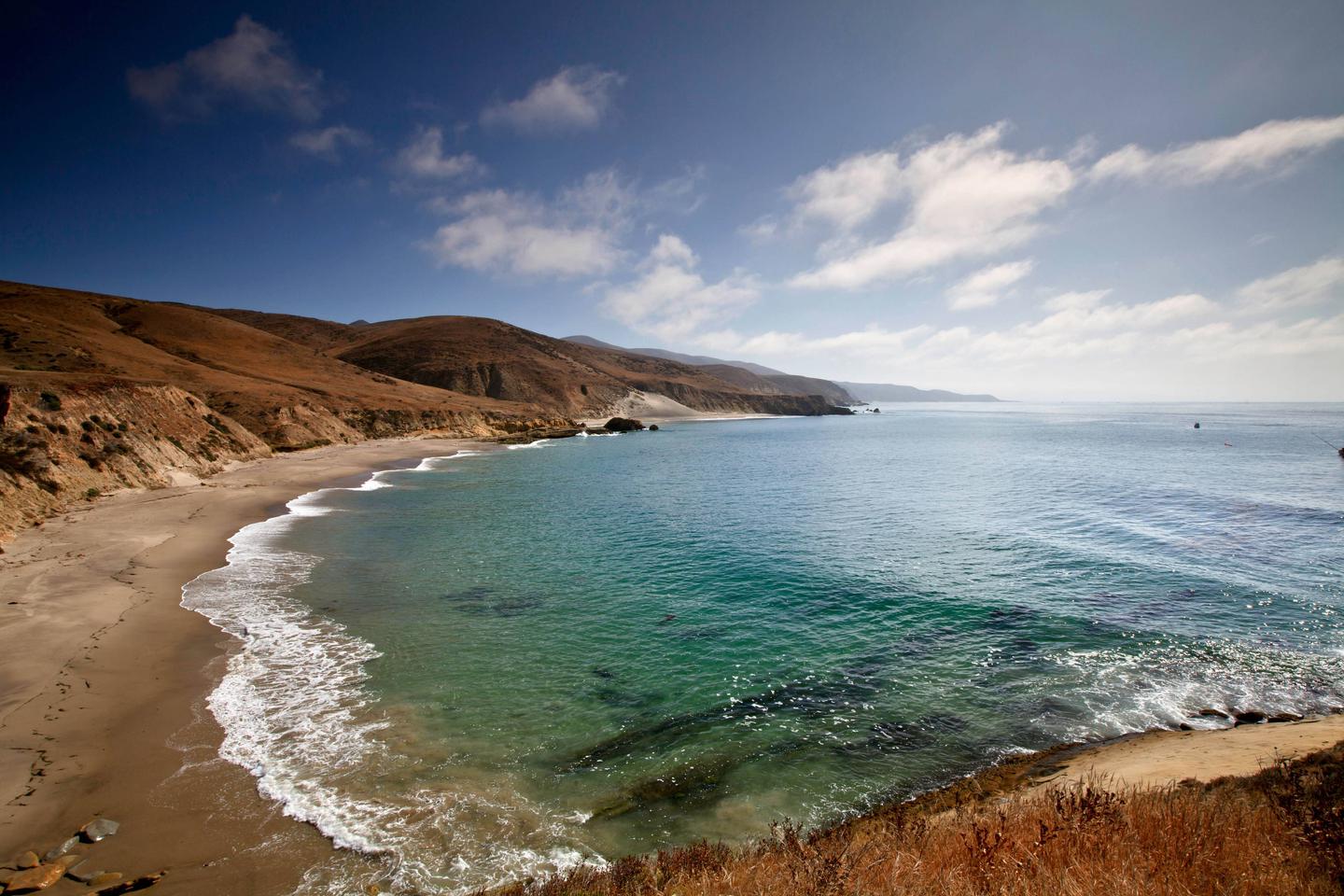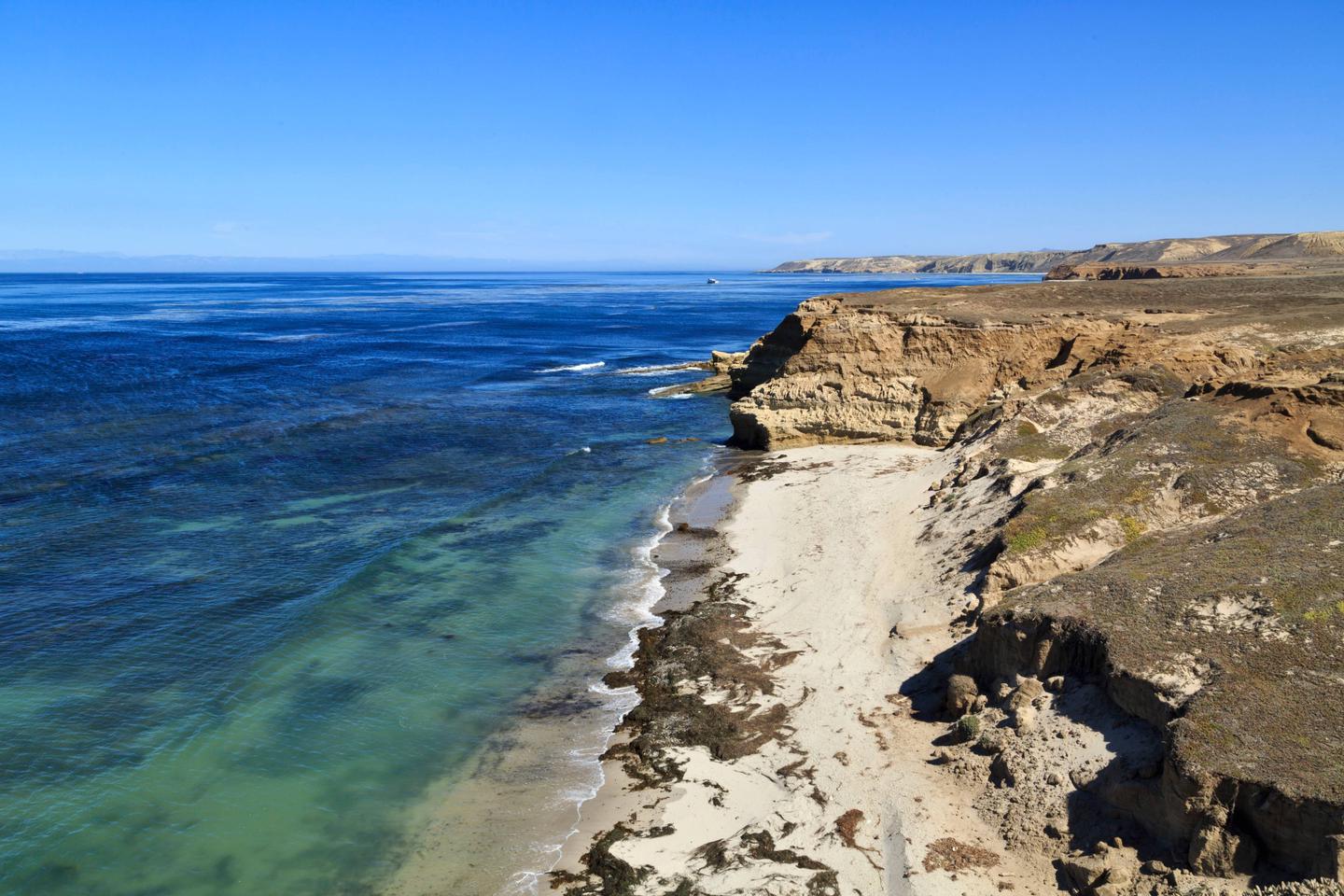Facilities
No facilities
This is primitive, dispersed, backcountry camping in tents with no established campsites nor electricity/water/sewer site hook-ups. Visitors must backpack to all locations and carry all of their own gear, food and water (see water information below).
Pack Out What You Pack In
Visitors are required to pack out what they pack in, including garbage and human waste. It is prohibited by law and regulation to leave human solid waste in the backcountry or in the wet intertidal sand. Human waste and toilet paper must be packed out for proper disposal using commercially available "waste bags".
Camp Only On Beaches
Visitors are required to camp on beaches. Camping is prohibited in any other areas, including coastal bluffs. Utilize sandy areas that are free of dune vegetation when hiking, landing water craft, and camping. Keep tents, kitchen areas, and traffic in "hardened" areas that are already bare from previous use. Do not damage live trees, plants, and other living things. It is not permitted to chop or nail trees, harvest or trample plants.
Water & Water Treatment
One gallon of water per person per day is recommended. Water weighs approximately 8 pounds per gallon. Potable water is available in the Water Canyon campground. During the backcountry camping season (mid-August through December), the only location outside the Water Canyon campground with an accessible, guaranteed water source is the Clapp Spring trough, approximately 7 miles from the pier [.6 miles south-southeast on Sierra Pablo Road from the intersection with South (Wreck) Road; 33°56’50” North, 120°03’19” West]. The water at Clapp Spring is safe to drink when boiled, filtered, or treated with iodine.
Although ten canyons may carry some degree of water intermittently throughout the year (except during dry years), water is not always available at the mouth of the canyons near the beach and can be dirty. These ten canyons include: Water, Trancion, Bee, San Augustine, Wreck, Jolla Vieja, Arlington, Soledad, Cow, and Lobo. Since the water in the streams can be contaminated with coliform bacteria and giardia, it is recommended that you boil, filter, and/or add iodine to the water.
Important Closures:
- Year-round. Camping is prohibited year-round between Carrington and East Point, except in the Water Canyon frontcountry campground, and at the beaches around Sandy Point and at Lobo Canyon.
- January 1 - August 14. All beaches are closed to backcountry beach camping to protect pupping seals/sealions and nesting seabirds.
- August 15 - September 15. Northwest and northeast beaches are closed to camping. Only the Southeast Quadrant (East Point to South Point Beaches) is open to backcountry camping. From September 16 through December 31, all Southeast, Southwest, and Northwest Quadrant beaches are open to backcountry camping.
- March 1 to September 15. Back beaches and sand dunes between and including Skunk Point to just north of East Point are closed to hiking to protect the nesting area for the snowy plover, a federally listed, threatened shorebird. Please remain on the wet sand (below mean high tide) or the throughout this area.
Additional Information
Please visit Backcountry Beach Camping: Santa Rosa Island on the Channel Islands National Park website for more information.
Natural Features
Weather
Weather conditions are generally best from August through October, with relatively calm wind and sea conditions and virtually no rain. Backpackers and kayakers should be prepared for strong northwest winds throughout the year, with the possibility of strong east or Santa Ana winds from October through January. The average wind speed is 15 knots, although speeds of 40 to 50 knots are not uncommon. Occasionally, the south side of the island (South Point to East Point) offers protection from these strong winds. Dense fog is common making chart and compass navigation mandatory. For the most current weather forecast, please visit Channel Islands National Marine Sanctuary's Internet Weather Kiosk .
Ocean Conditions
Kayakers may encounter strong ocean currents around the islands. Intense wave and surf conditions exist around the Carrington Point area. Sheer cliffs rise out of the ocean, reflecting incoming waves back out to sea, creating a washing machine effect. In this turbulent area there are no places to land, even in an emergency. The first landable beach is Lobo Canyon, five miles west of the ranch area pier. Rounding Skunk Point may be tricky as well because of merging currents. The wind often increases in the afternoon, and the prevailing northwesterlies can make paddling back to Water Canyon difficult. During the summer months, large swells often pound the south side of the island, making landing and launching from the beaches extremely challenging, requiring advanced skills. Ocean water temperatures range from the lower 50s (F) in the winter to the upper 60s (F) in the fall.
Recreation
Boat and Airplane Drop Off Points. The park boat concessionaire, Island Packers, usually drops off and picks up kayakers and backpackers at the pier near the ranch area in Bechers Bay. The park airline concessionaire, Channel Islands Aviation, drops hikers at the end of the airstrip near Water Canyon, approximately one mile from the pier and a 1/2 mile from the frontcountry campground in Water Canyon.Trail Conditions. Hiking to beach camping areas is along the beach, dirt roads, or unmaintained paths created by island animals. These roads and paths are rugged and mountainous with no signs.
Maps. Please refer to topographical maps for more accurate mileage and to help with the following descriptions. It is recommended that all backpackers purchase topographic maps (USGS 7.5 minute maps or the Trails Illustrated map of all the islands) and kayakers purchase nautical charts before departing on their journey.
Hiking and Kayaking Distances. All distances that follow are approximate and measured in miles from the pier, unless stated. Please see Hiking Santa Rosa Island for descriptions of other hikes on Santa Rosa Island.
Southeast Quadrant
- East Point: 7 mi (11 km) hiking; 8 mi (13 km) kayaking*
- East Point to Ford Point: 8 mi (13 km) hiking; 5 mi (8 km) kayaking**
- Ford Point via South (Wreck) Road: 9 mi (14.5 km) hiking+
- Ford Point to Johnsons Lee: 4 mi (6.5 km) hiking; 3.5 (6 km) kayaking+
- Johnsons Lee (via East Point): 18 mi (29 km) hiking; 16 mi (26 km) kayaking**
- Johnsons Lee via Main (Soledad) Road: 14 mi (22.5 km) hiking+
- Johnsons Lee via South (Wreck) Road: 13.5 mi (22 km) hiking+
- La Jolla Vieja via South (Wreck) Road: 11.2 mi (18 km) hiking+
* Camping Just South of East Point is NOT Recommended. While no camping is allowed at East Point, there is a small pocket beach just to the south in the Southeast Quadrant that is open to camping between August 16 and September 15. However, it is not recommended for camping as this beach is very, small and may be washed out at higher tides. In addition, pounding surf and strong winds constantly reshape this beach.
** Hiking Beyond East Point. If hiking beyond East Point to Ford Point, it is recommended that you follow the ridge line or road until you reach the northeast ridge of San Augustine Canyon. Follow this ridge down to the mouth of the canyon. Hiking along the beach from East Point to Ford Point is impossible due to section of vertical cliffs that drop directly into the ocean. However, kayakers can access beaches throughout this area. Once hikers reach Ford Point, they may follow the low terrace or higher ridge (both eventually run into a coastal road) down to the Johnsons Lee area. Refer to topographical maps for more information.
+ Direct access to beaches between Johnsons Lee and Ford Point (including La Jolla Vieja) is also possible via the Main (Soledad) or South (Wreck) roads. Both of these routes are long hikes and with a considerable amount of climbing and, once again, like all hiking or kayaking on the island, is recommended only for the experienced, well-conditioned traveler.
Southwest Quadrant
Backcountry camping in the Southwest quadrant is extremely difficult and only recommended for experienced backpackers due to long distances, frequent high winds, and lack of reliable water sources.
- China Camp Beach (closest beach in Southwest Quadrant): 13 MI (21 km) hiking; 25 mi (40 km) kayaking.
Northwest Quadrant
Backcountry camping in the Northwest quadrant is extremely difficult and only recommended for experienced backpackers due to long distances, frequent high winds, washed-out beaches at high tides, and lack of reliable water sources.
- Dry Canyon: 10 mi (16 km) hiking; 11 mi (17.7 km) kayaking++
++Beginning September 16, the closest beach camping is Cow Canyon. However, this beach can wash out at high tide and/or large swell and is NOT recommended. Nearby Lobo Canyon beach is closed to beach camping and only available for day use. Therefore, Dry Canyon is the closest beach in the Northwest Quadrant that is recommended for camping.
Recreation Sites
- Tent Only Nonelectric
- Overnight
Activities
- Hiking
- Camping
- Boating
- Beach Camping
- Beachcombing
- Birding
- Fishing
- Photography
- Sailing
- Snorkeling
- Swimming
- Wilderness
- Water Access
- Water Sports
- Wildlife Viewing
Amenities
- Beach Access
Getting Here
Need to Know
Camping Maximum. Ten groups per night, per quadrant. Max 4 campers per group. One party or group may reserve a maximum of 2 sites per visit.
Check-in. Check-in with a ranger on arrival for an on-site orientation. Bring your confirmation email with you. Check-in and check-out times are at 11:00 a.m. Quiet time is enforced at 10:00 p.m.
Biosecurity. To help prevent the introduction of nonnative species the following items may not be brought to the park: pets; live or potted plants; soil; cut flowers; firewood or any untreated, unfinished wood (including hiking sticks); corrugated boxes; tools or equipment with attached soil; motorized vehicles; bicycles; and single-use plastic grocery bags. Prior to departure, visitors are required to use pest-proof packing materials, inspect and clean their gear and shoes of all soil, seeds, and insects. Learn more about biosecurity and watch the required video at Protect Your Park Through Biosecurity.
Important Closures. Visitors are required to be aware of island closures. Please read 'Island Closures'.
Everytinng is Protected As in all national parks, it is illegal to feed, collect, disturb, or harm park wildlife, plant life, or other natural, historical, and archeological features. Taking from or disturbing archeological sites or artifacts is a violation of state and federal law. The archeological sites around the Channel Islands are a testament to the importance of the Chumash and other American Indians. Archeological sites are sacred to Chumash peoples today, are protected by federal law, and are a vital nonrenewable scientific resource. Please help us in protecting and preserving this rich part of California’s heritage.
Additional Information. Please visit Backcountry Beach Camping: Santa Rosa Island on the Channel Islands National Park website for more information.
Contact Information
For campground inquiries, please call: 805-658-5730




